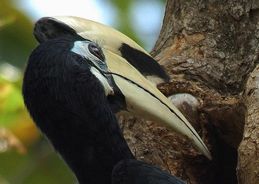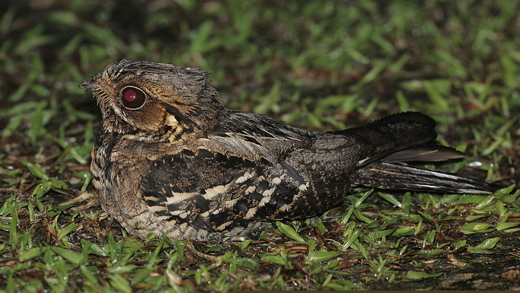On 9th February 2007, Heng Fook Hai posted a close-up image of the Oriental Pied Hornbill (Anthracoceros albirostris) and he noticed something he did not see before. So he posed the following questions:
“I seldom see birds with long eyelashs until my recent photo of the hornbill (left). I searched my other bird photos but did not find any other birds showing eyelashes. Is there other bird with such long eyelashs?
“I remember BESGroup did show a kingfisher with eye membrane to protect their eyes. Just curious what function do the eyelashes serve?”
This got me curious, so I looked up the relevant literature. It seems that these are actually bristles, highly specialised contour feathers in which the rachis or feather shaft lacks barbs. Such bristles are found at the base of the bill. Ornithologists term these rictal bristles. And rictal bristles are seen in many species of birds that catch insects, like nightjars (below), flycatchers, owls, swallows and hawks.
So what are the functions of rictal bristles? Some suggest that they help to funnel insects into the mouth, but this has no experimental basis. And what about the bristles around the eyes? There appears to be consensus that they protect the eyes from flying insects and other debris. Especially when the bird catches large scaly insects like butterflies and moths. Rictal bristles also help the bird to detect movements of insects held in the bill, just like the whiskers of some mammals.
Images: Fook Hai (hornbill) and Chan Yoke Meng Large-tailed Nightjar Caprimulgus acrurus).











10 Responses
I had never noticed that. Thanks for pointing that out.
I can tell you for a fact that there are several different types of birds that have eyelashes. When I was a tot we went to a petting zoo. Atop a pile of rocks was a solid black bird with a very long black beack. This bird had “showgirl” eyelashes. I noticed them from afar. I asked the keeper if I could pet the bird and he said “You can try…” and to a kid that sounds like “Sure! Go aheah!” I climbed the pile of rocks and had a good look at the bird and petted him. The eyelashes were unbelievably thick and long. This raised a number of questions in my young mind because I had never seen a bird with eyelashes before (not that I had noticed anyway)and I wasn’t sure they were even real. This made me wonder “Just how bored does a petting zoo keeper have to get to glue eyelashes on a bird, and what sort of glue did he use?” Ever since I have been on a quest to find out exactly WHAT these eyelashes were (are they the same as hairs? What makes them different from hair exactly, etc.) and what they were for. The keeper told me that the bird was probably from Africa, but he wasn’t sure. I have never seen this bird pictured anywhere and would love to know what kind of bird it was. I am so glad that I am not the only person who has noticed eyelashes on birds.
I had a budgerigar that had eyelashes, which I photographed using a powerful macro lens. My current pet bird is a sun conure (also a parrot), but it does NOT have eyelashes – it’s still a baby, so perhaps it will develop them.
I was looking at some Crested Cara Cara pictures I took yesterday (not those on my website) and it has definate eye lashes not only hairs near the bill. I wouls post the picture or crop if there was an upload and would email anybody interested if they used the contact me form.
Thanks Dennis. Would appreciate images.
A lot of the hornbills have eyelashes. Go look lovingly deep into the eyes of the Rhinoceres, Great Indian and Wreathed Hornbills at the Jurong Bird Park.
Secretary birds (Sagittarius serpentarius) have rather distinctive long black “eyelashes”. Bearded barbets (Lybius dubius) are an excellent example to view rictal bristles. The species is named after it’s prominent specialized feathers.
Budgerigars have eyelashes.